Creative Europe 2024: Slovenia’s Imprint on the European Cultural Space
Slovenia’s Imprint on the European Cultural Space
The Only EU Programme Entirely Dedicated to Culture and Film
Creative Europe is the only specialised programme of the European Union devoted to supporting the cultural and creative sector (CCS) as well as the audiovisual (AV) sector. The programme enables artists, producers, organisations and institutions to collaborate on projects, reach wider audiences and engage in European networks and international exchanges. At the same time, it encourages the development of innovative, culturally and linguistically diverse practices that respond to contemporary social, digital and environmental challenges.
The programme is structured into three thematic strands, forming a unique European platform for the sustainable, inclusive and digitally oriented development of creativity. The Culture strand supports all cultural and creative sectors, except for the audiovisual sector (for instance, performing arts, literature, cultural heritage etc.). The MEDIA strand, targeting the film and audiovisual sector, supports AV project development, distribution, promotion, professional training and more. The Cross-sectoral strand fosters collaboration between different sectors and also includes support for the news media sector.
Slovenia continuously achieves above-average results in Creative Europe – and 2024 was no exception. Slovenian organisations were successful across all three strands, both as project leaders and partner organisations. Creative Europe has proven to be an exceptionally important mechanism for positioning Slovenian stakeholders within the European cultural landscape.
Outstanding Achievements of Slovenian Organisations
In 2024, Slovenian organisations once again exceeded the results of previous years: as many as 54 different organisations, acting as leaders or partners, are participating in 52 projects. Across all three strands of the Creative Europe programme, they received 61 grants totalling 7.4 million EUR, representing a significant investment in the domestic creative and cultural ecosystem. In total, EU support for projects involving Slovenia amounts to approximately 17.3 million EUR.
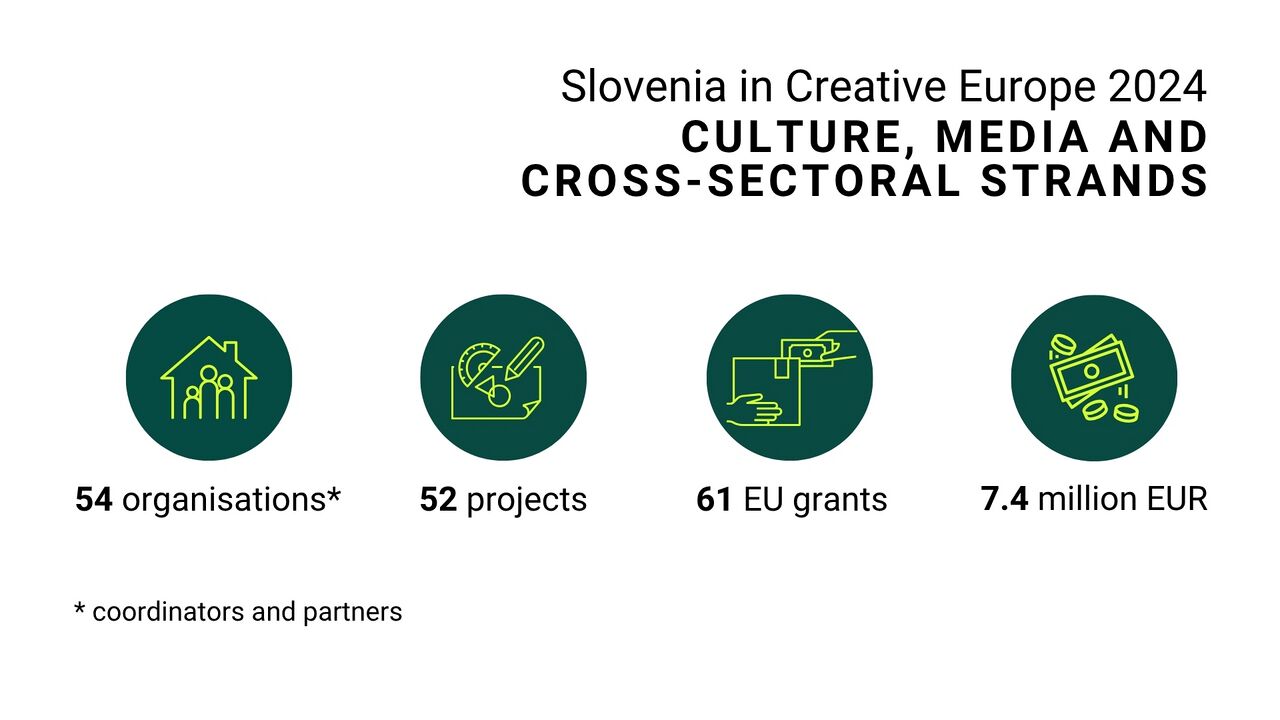
New emphases, new coordinates
In 2024, Slovenia’s strong representation in the Cross-sectoral strand added a vital dimension to its multi-year success in the Culture and MEDIA strands. Despite its small size, Slovenia is effectively developing European projects at the intersection of media, culture and new technologies. Supported projects reflect the thoughtful engagement of Slovenian stakeholders in shaping the future through cross-sector connections and digital innovation.
Whereas in the past, Slovenian participation in the programme was almost exclusively represented by organisations based in Ljubljana, today the Creative Europe map for Slovenia looks quite different. Sixty-five participating organizations (including associated partners without EU funding) can be found not only in Ljubljana, Maribor, Kranj and Koper, but also in smaller towns such as Trbovlje, Velenje, Vojnik, Murska Sobota, Nova Gorica and Črni Vrh nad Idrijo. For the first time, Cerknica, Dobrovo v Brdih, Jesenice, Lenart, Podgorje pri Slovenj Gradcu, Radomlje, Slovenska Bistrica, Škofja Loka, Šmarje pri Jelšah and Zagorje ob Savi have appeared on the map. Thus, places that were rarely seen in the European context are becoming co-creators of international exchange in culture.
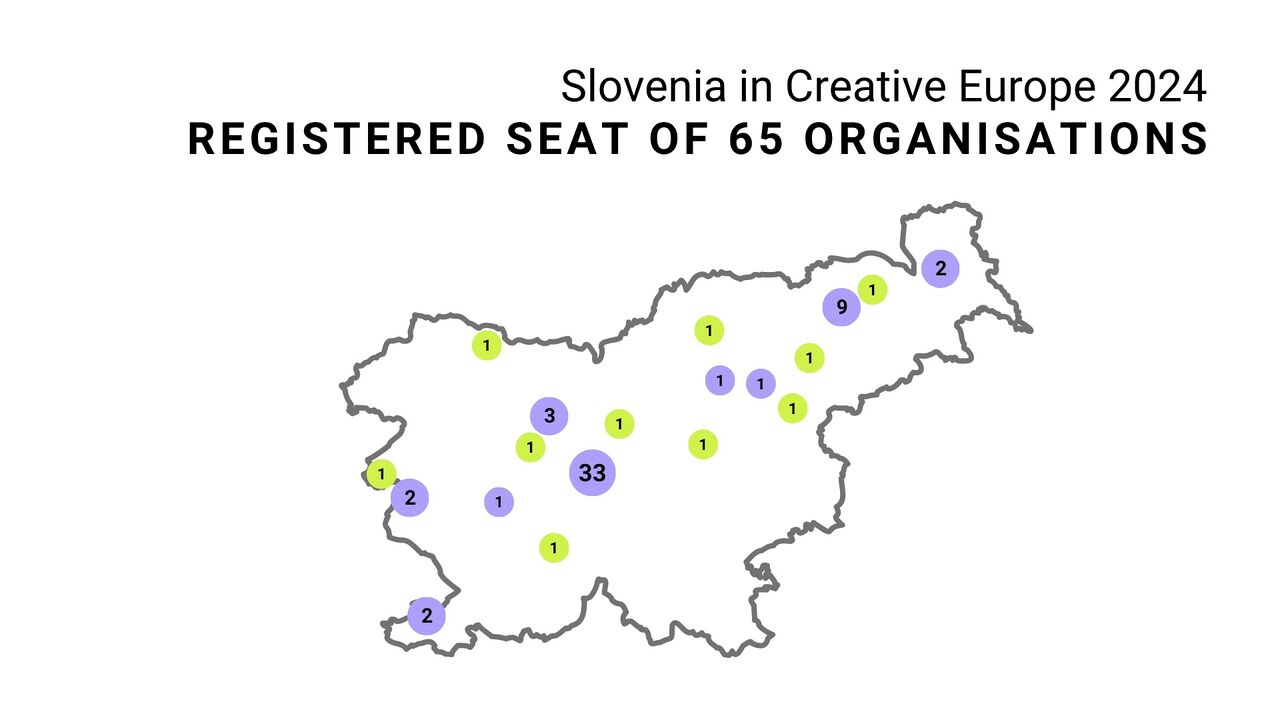
Alongside this marked decentralisation, another notable feature of the 2024 results is the increased representation of public institutions. Of the 65 participating organisations, nearly half (30) are public institutions, followed by NGOs (23), which had always taken the lead until now. Companies are represented to a lesser extent (10). This variety of institutional types demonstrates that the programme is accessible to and needed by both micro-organisations and major national cultural institutions.
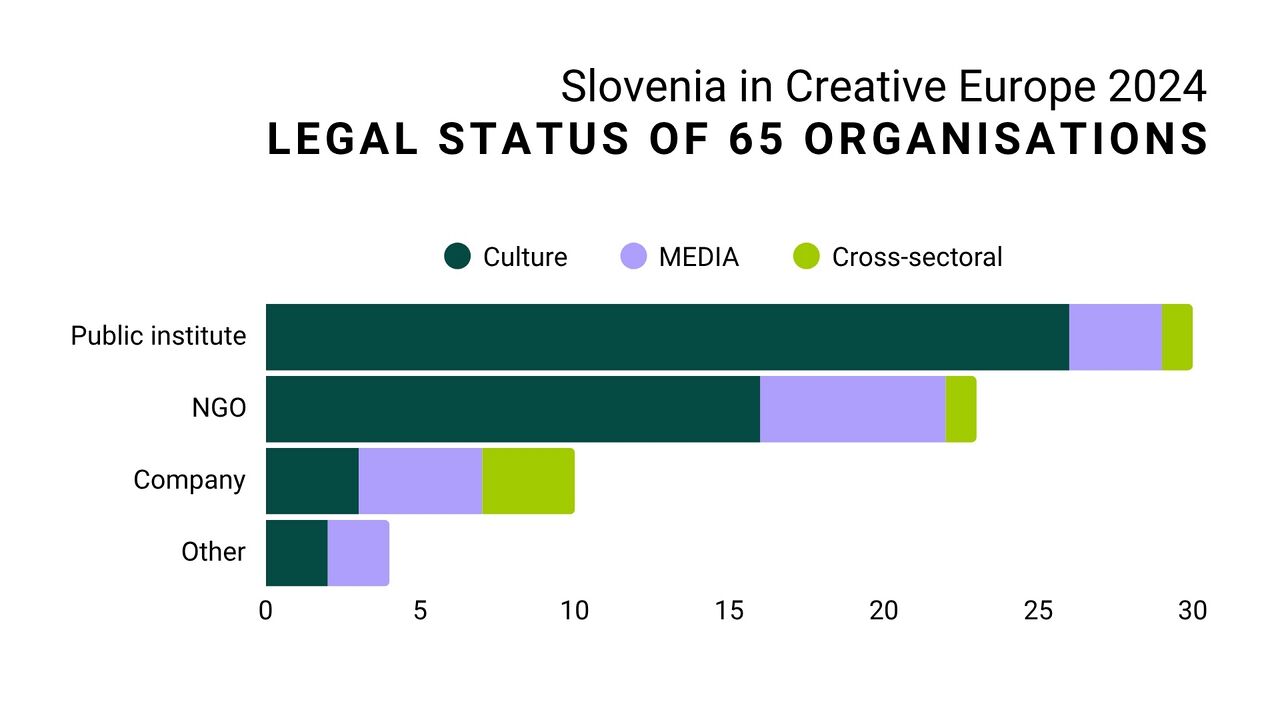
EU grants by sector
Projects involving Slovenian organisations cover a broad spectrum of cultural and artistic fields. Among the 61 EU grants, film and audiovisual activities stand out the most (16 grants), followed by the performing arts with music (11) and cultural heritage (10). Interdisciplinary projects (7), literature (6) and news media (4) also feature significantly, while multimedia and new technologies, design and applied arts, and architecture appear with one or two grants each.
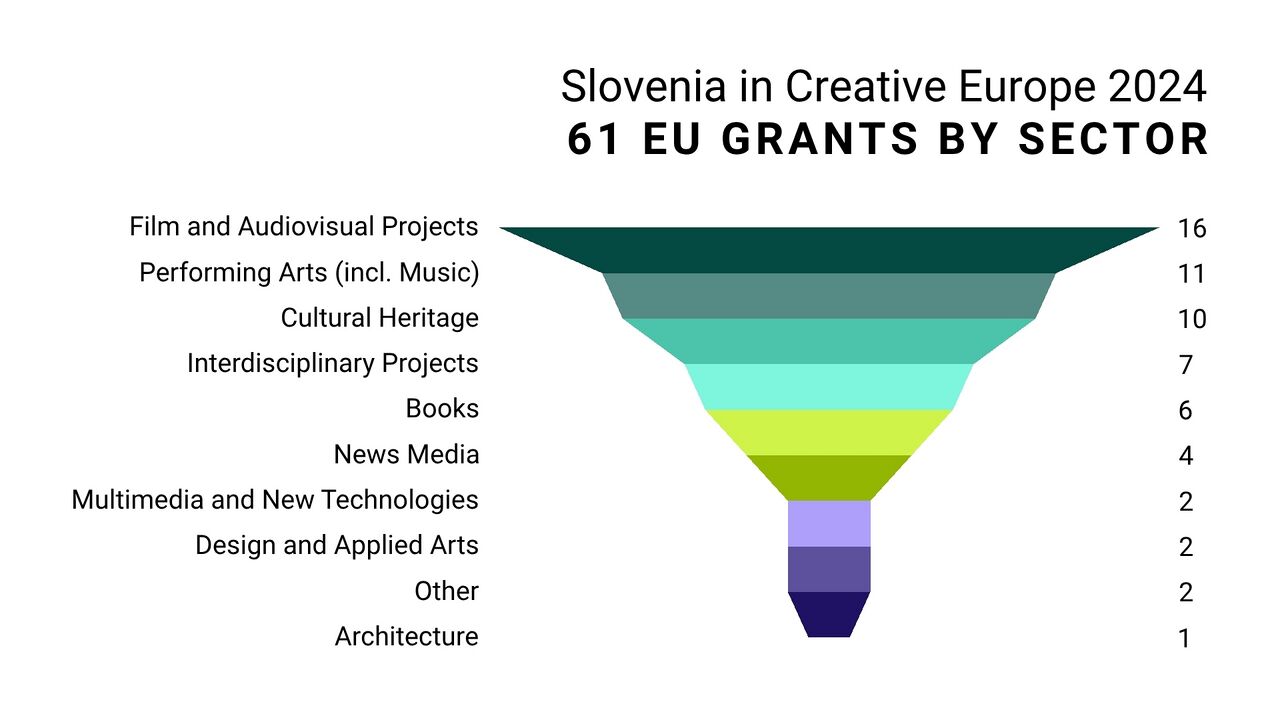
Due to the wide variation in grant amounts across different calls, the number of grants does not necessarily correspond to the total funding. Performing arts with music received the largest amount of funding (1.52 million EUR), followed by film and AV (1.37 million EUR), interdisciplinary projects (1.18 million EUR), and literature (1.15 million EUR). Cultural heritage received 750,504 EUR across 10 grants, while architecture received around 700,000 EUR, entirely through a single grant for a European platform.
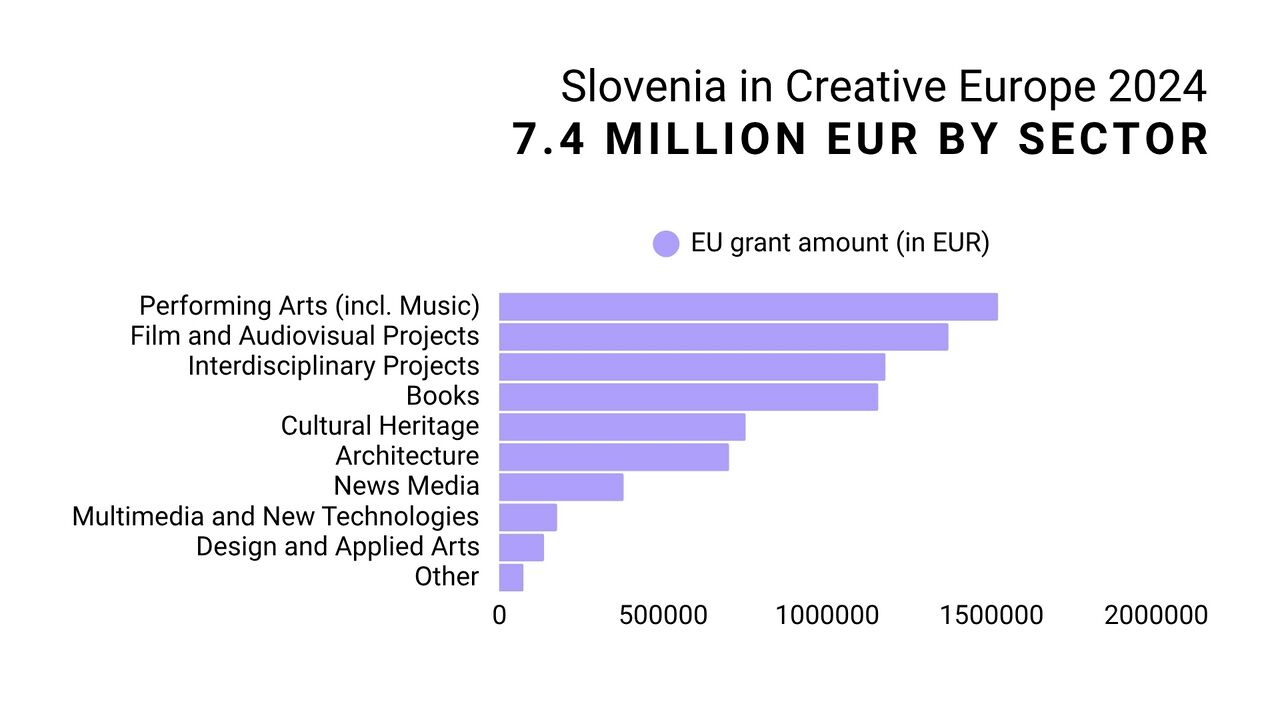
Culture: Cooperation and Networking
The Culture strand is the primary mechanism supporting diverse artistic and cultural practices — from visual arts and music to cultural heritage and literature. In 2024, 38 Slovenian organisations received support, participating in 33 projects. Within this strand, they received 40 EU grants, totalling approximately 5.3 million EUR.
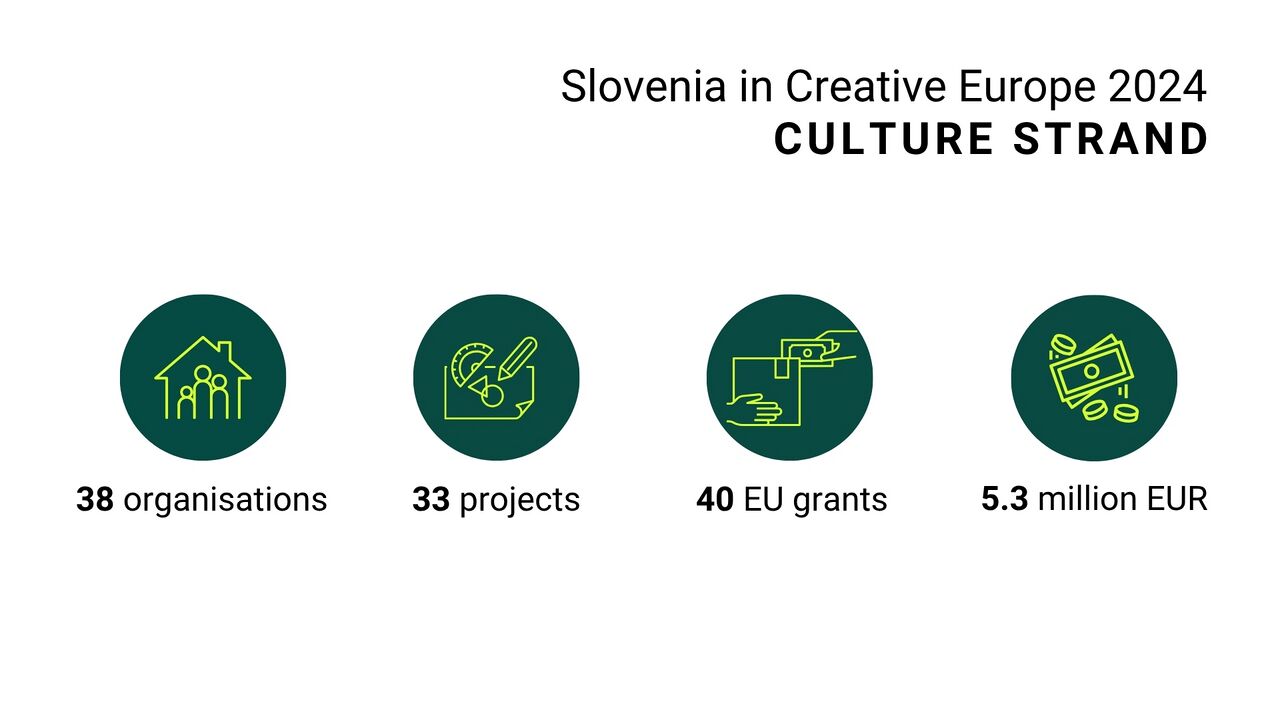
European Cooperation Projects
The largest portion of the Culture strand budget goes to European Cooperation Projects (COOP), where Slovenia excelled in 2024. A record 963 applications were submitted to the call, of which 159 projects were selected from 935 eligible ones. Impressively, 11 of these 159 have Slovenian project leaders, placing Slovenia third in the number of led projects, behind Italy (21) and Belgium (13). A total of 35 Slovenian organisations received support, participating as leaders or partners in 30 projects and creating 137 international connections with 33 European countries. Slovenia secured 3.8 million EUR in support, 6.3 % of the available budget.
Projects involving Slovenia address a range of contemporary challenges. For example, two projects led by the Faculty of Design (Multisensory Art) and Aspira Institute (ArtElevate) focus on accessibility and the inclusion of vulnerable groups. Similar themes are addressed in projects where Slovenian organisations participate as partners — such as Maribor Public Library (Heroes Unleashed), EPeKa Scientific and Research Association (Roma Soul Food) and Risa Institute (PAGE). A significant number of projects emphasise the role of culture in mental health and well-being, including the SPA Festival led by [[Bunker Institute] and projects involving Asociacija (CARE – Culture for Mental Health) and Kranj City Library (Libraries of Emotions for Good) as partner organisations.
Other key thematic priorities include the digital transformation and artificial intelligence (e.g., in projects led by the Institute for Transmedia Design (ITD) and Innovato Institute), as well as environmental sustainability and ecology (e.g., in projects led by the Trajna Collective and the Ljubljana Puppet Theatre). Several projects explore various forms of cultural heritage and local identity (e.g., those with partners such as ZRC SAZU, Carnica Institute for Culture and Tourism, Center Rog and the Upper Sava Valley Museum, Jesenice), use art as a tool for participation and social dialogue (e.g., partners like ZIZ Collective, KD IGLU, MoTA Museum of Transitory Art, the Young Dragons (Mladi zmaji) Public Institute and TiPovej! Institute), or link art with education and the development of young audiences (e.g., Ljubljana City Library and Pionirski dom Youth Culture Centre). Regardless of the thematic focus, international cooperation and the building of lasting partnerships are horizontal priorities across all projects.
Circulation of European Literary Works
In 2024, under the Circulation of European Literary Works (LIT) call, among 34 selected publishers from 18 countries, the Slovenian publisher VigeVageKnjige was chosen for its project Word: Enhancing European Graphic Novel Perception, Circulation and Market Development. An EU grant of 200,000 EUR enables comprehensive promotion and thematic events to raise the visibility of graphic novels, as well as systematic measures to improve market conditions – such as organising a graphic novel festival, participating in fairs and providing training for librarians.
European Platforms
In 2024, the European Commission selected 19 European platforms that promote the international visibility of emerging creators and will co-finance them from 2025 to 2029. The platform leaders come from eight countries, including two from Slovenia – a remarkable achievement on the European scale.
The poetry platform VERSOPOLIS – Where Poetry Lives, led by Beletrina Publishing Institute with 33 members from 29 countries, supports young European poets and promotes their mobility through European festival appearances. Total EU support amounts to over 2.6 million EUR, including 667,577 EUR for the year 2024.
The architecture platform LINA – Learn, Interact and Network in Architecture, coordinated by the Faculty of Architecture at the University of Ljubljana with 30 members from 24 countries, received 2.8 million EUR in total, including 700,000 EUR for 2024.
Other Slovenian members of European platforms include En-Knap (Aerowaves – dance), Asociacija (Culture and Health – art at the intersection of culture, health and the social sector), Center Rog (Craftwork 4.0 All – crafts and manufacturing), SIGIC (Exchange – popular music), Kino Šiška Centre for Urban Culture (Liveurope – concert venues; UPBEAT – music showcase festivals), and Goga Publishing House and Beletrina Publishing Institute (CELA – literature and publishing).
MEDIA: Slovenia’s AV Creators Make Their Mark
In 2024, Slovenian audiovisual sector demonstrated its creative strength and international scope once again. Twelve organisations participate in 16 projects, securing 1.4 million EUR in EU support. Their iniciatives enhance the development, distribution and promotion of high-quality European audiovisual content, fostering connections between creators, audiences and markets.
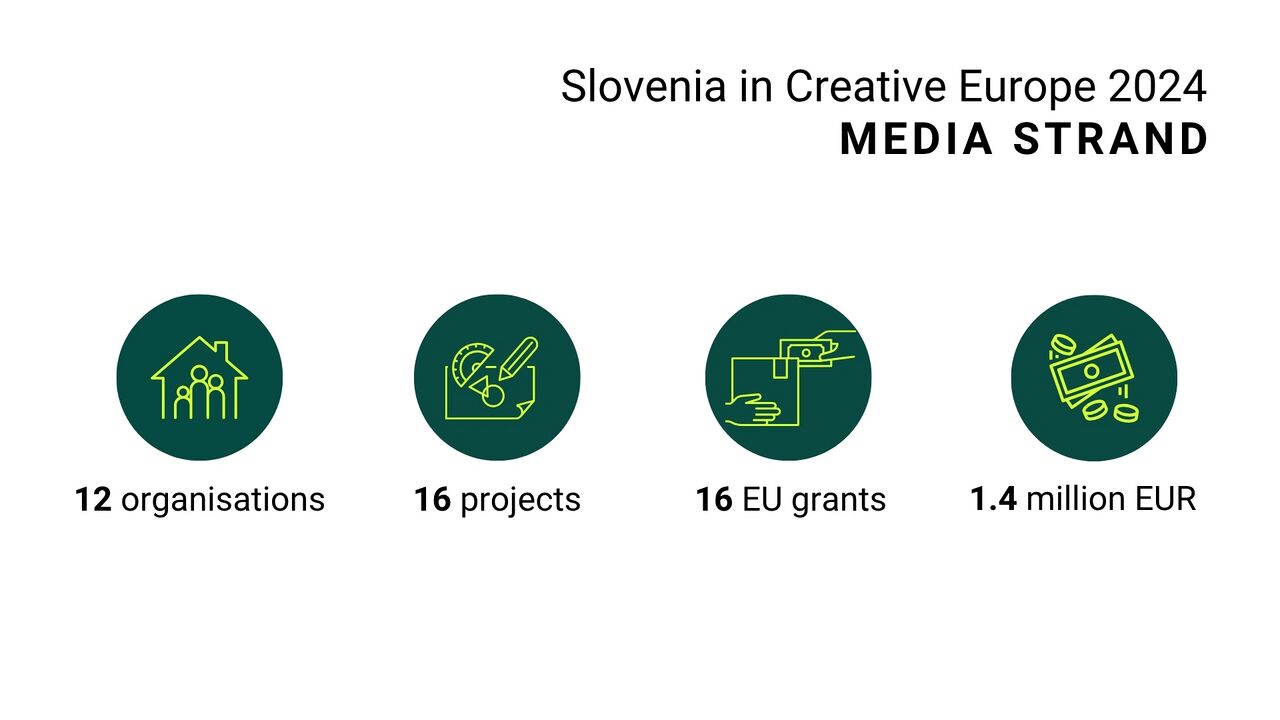
Co-productions with a European Mark of Quality
Developing high-quality content with international potential remains one of the core objectives of the MEDIA strand. In 2024, two Slovenian production companies, Staragara and Cvinger Film, secured funding for film development.
The European Slate Development call is open to production companies from countries with varying levels of production capacity. Staragara’s project was one of only six selected from countries with lower production capacity. This success is truly remarkable, considering that Staragara secured funding in what was the most competitive round to date, with as many as 208 projects submitted.
Cvinger Film’s selection under the European Mini-Slate Development call, which is specifically aimed at producers from countries with lower audiovisual production capacity, confirms Slovenia’s stable presence in this segment.
Connecting and Developing Creators
Slovenian AV organisations are helping to shape the European landscape that promotes quality film and strengthens the capacity and collaboration of creators. The Slovene Animated Film Association (DSAF), as leader of the CEE Animation Workshop and partner in two complementary international initiatives, significantly contributes to animation in Central and Eastern Europe.
Slovenia on the European Film Festival Map
With EU support, Otok Cultural Institute organised the milestone 20th edition of the Kino Otok - Isola Cinema Festival and is active internationally as the leader of the Young4Film network of film festivals. Strengthened by fresh approaches and a new partner from Spain, the network secured further two-year EU funding in the 2024 call.
2 Reels - Association for Reanimation of Storytelling continues their successes with support for the promotion of contemporary world and European auteur animation, with a focus on Central and Eastern Europe. In addition to support for the 21st Animateka, the association also receives co-financing for its partnership in the international Animation Festival Network.
In 2024, Kraken Film Society received EU support for the FeKK Ljubljana Short Film Festival for the first time, securing a place among prominent European festivals. Kraken is also part of the European Network of Film Discourse. Cankarjev dom, Film Programme was supported as a partner of the Network of Festivals in the Adriatic Region.
More European Film Highlights for Slovenian Audiences
A major MEDIA achievement is ensuring the circulation of European films beyond production countries. Slovenian distributors Blitz, Fivia and Demiurg have secured funds to reinvest in the promotion and exhibition of European films domestically. Alongside Cinemania, they also took part in promotional campaigns within the Films on the Move scheme, in collaboration with leading European sales agents to ensure broader access to European films across the continent.
European films could not reach the public without the cinemas that screen them. The Art Cinema Network of Slovenia, comprising 28 cinemas in 27 Slovenian towns, ensures that quality and art films, as well as film education, reach audiences. Most (22) are members of Europa Cinemas, the only European network dedicated to promoting European film screenings. Slovenian members of Europa Cinemas also received support in 2024 for screening European films and film education activities.
What About Youth, Accessibility and New Audiences?
Through its support for audience development and film education, Creative Europe strongly encourages socially engaged projects that use film to address socially relevant themes and reach younger audiences. Since 2023, Kinodvor Cinema, Šmarje pri Jelšah Library, EPeKa Scientific and Research Association and Notranjski Regional Park have formed 22 partnerships across 16 countries through multi-year initiatives launched in 2024 – linking film with hospital environments, accessibility, sustainability and even gaming culture.
Cross-Sectoral Strand: At the Intersections of Media, Culture and Technology
2024 brought exceptional results for Slovenia in the Cross-sectoral strand. Five Slovenian organisations were successful with three projects in highly competitive calls – Creative Innovation Lab and Journalism Partnerships. These initiatives secured over 730,000 EUR in funding for Slovenia and established 27 partnerships across 10 countries.
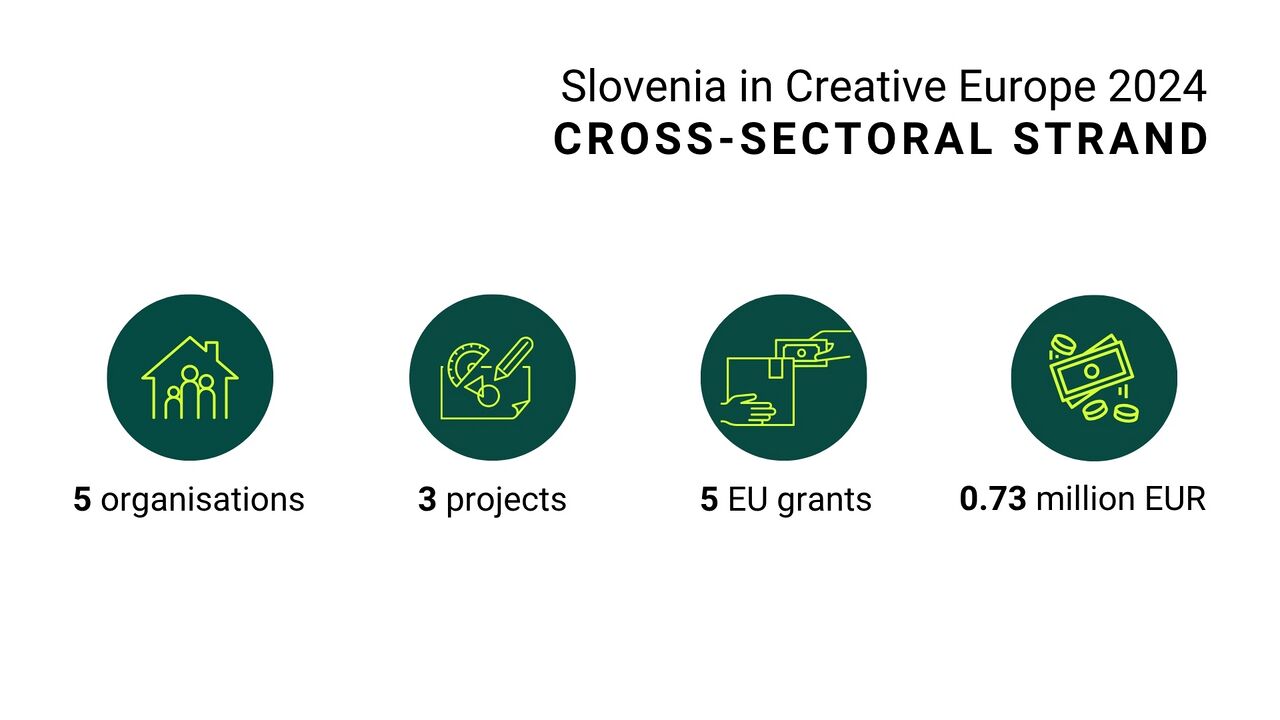
Among them is Beletrina Digital, an innovative multimedia platform by Beletrina Publishing Institute offering e-books, audiobooks, films, podcasts and journalistic content. It was one of only ten supported projects under the Creative Innovation Lab call – and the only one from Slovenia.
On the Journalism Partnerships call, only six projects were selected. Remarkably, two are led by Slovenian organisations. RTV Slovenia leads ENACT, aiming to develop easily accessible audiovisual news for web, radio and TV. Salomon, as the leader, together with Večer mediji and Primorske novice as partners in MEDEXCHANGE24, is focusing on improving the use, management and sharing of digital content among European media.
The Unprecedented Scale of Slovenia’s International Cultural Networking
Slovenian organisations that received support across all strands of Creative Europe last year (counting only the platforms within the Culture strand led by Slovenian organisations, not those where they participate solely as members) forged an impressive 240 international partnerships across 35 countries.
The highest number of partnerships was made with Spain (17), followed by Italy and Serbia (16 each), Croatia and Poland (13 each), and Belgium and Austria (10 each). Out of the 40 European countries currently participating in the Creative Europe programme, Slovenian organisations did not cooperate this time with only four: Iceland, Liechtenstein, Luxembourg, and Tunisia. Creative Europe remains immensely significant for Slovenia’s international engagement in culture.
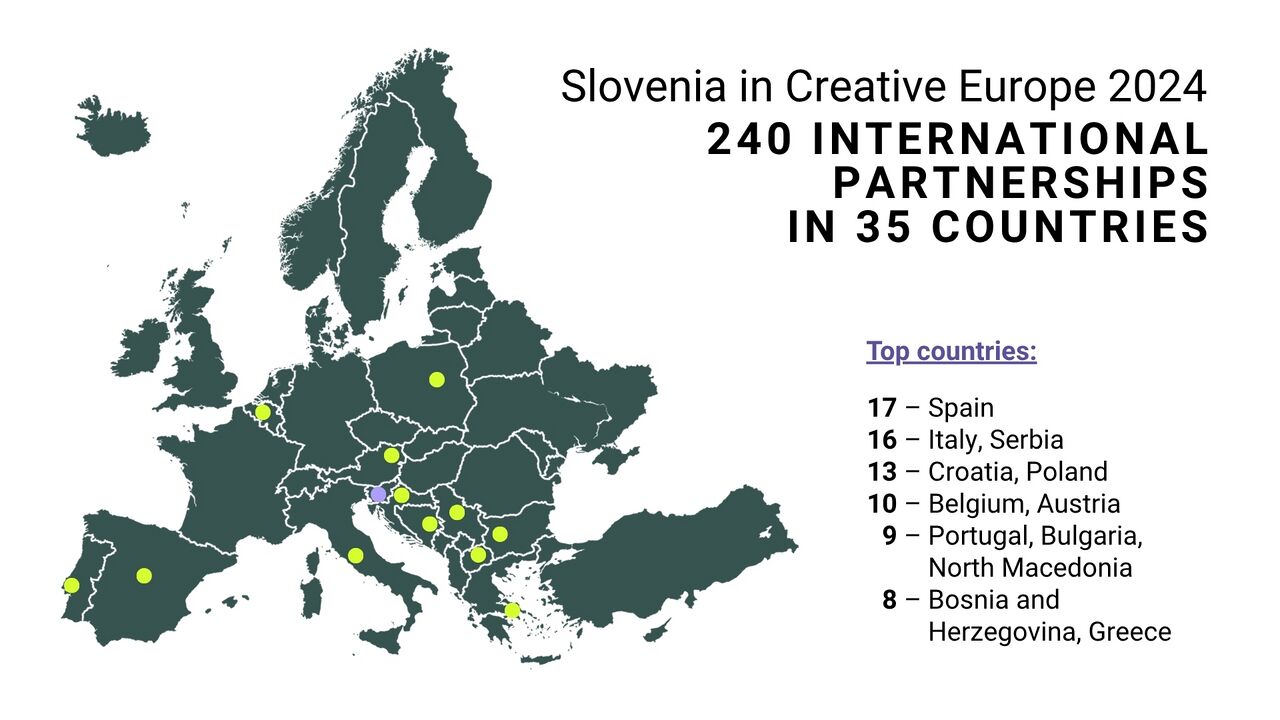
Author bio
The text was written by the Motovila Institute team: Mateja Lazar, Nika Mušič and Sabina Briški Karlić, in August 2025, in the framework of the public procurement "Development and upgrade of information portals of the Ministry of Culture for the transition to the eKultura platform" in which Motovila Institute collaborates as a partner with Ljudmila Art and Science Laboratory.
Alphabetical List of EU Grant Recipients in 2024 (leaders and partners)
- 2 Reels - Association for Reanimation of Storytelling
- AKMS
- ARCTUR Računalniški inženiring d.o.o.
- Art Rebel 9
- Asociacija
- Aspira Institute
- Beletrina Publishing Institute
- Blitz Film and Video Distribution
- Bunker Institute
- Cankarjev dom, Film Programme / Ljubljana International Film Festival (LIFFe)
- Carnica Institute for Culture and Tourism
- Center Rog
- Cinemania Group
- Cvinger Film
- Delavski dom Trbovlje Cultural Centre
- Demiurg Film Distribution (Flakus Cvetka)
- EPEKA
- Faculty of Design
- Festival Velenje Public Institute
- Fivia d.o.o
- Innovato Institute
- Institute for Transmedia Design (ITD)
- Iskriva, Institute for Development of Local Potentials
- KD IGLU
- Kibla
- Kraken Film Society
- Kranj City Library
- Ljubljana City Library
- Ljubljana Puppet Theatre
- Maribor Public Library
- Maribor Puppet Theatre
- MoTA Museum of Transitory Art
- Museum and Galleries of Ljubljana
- Otok Cultural Institute
- Pionirski dom Youth Culture Centre
- Prešeren Theatre Kranj
- Primorske novice d.o.o.
- Projekt Atol Institute
- RISA Institute
- RTV Slovenia
- Salomon d.o.o.
- Shape d.o.o.
- Slovene Animated Film Association (DSAF)
- Šmarje pri Jelšah Library
- Staragara
- TiPovej! Institute
- Trajna Collective
- University of Ljubljana
- University of Primorska
- Upper Sava Valley Museum, Jesenice
- Večer Newspaper
- VigeVageKnjige
- Mladi zmaji (Young Dragons) Public Institute
- ZIZ Collective
- ZRC SAZU
See Also
- Creative Europe Desk Slovenia
- Motovila Institute
- The First Decade of the EU Creative Europe Programme
- Creative Slovenia up to 2020: a fascinating feat
- A list of all Slovenian organisations funded by the Culture and MEDIA Programmes 2000–2020